Energy Consumption Optimization of Milk-Run-Based In-Plant Supply Solutions: An Industry 4.0 Approach
Abstract
:1. Introduction
2. Literature Review
- The literature stated various applications of the developed I4.0 technologies in the manufacturing and in-plant supply areas with a high potential of raising the efficiency of energy consumption. This reflects the high expectations of achieving a positive impact through the adoption of these technologies.
- I4.0 technologies are expected to contribute directly to digitalization, full product life analysis, dynamic feedback, and other tools that could achieve more deep and inclusive analysis to reach higher optimization in the investigated systems.
- While many studies worked on finding and presenting the benefits of I4.0 technologies in manufacturing and in-plant supply, further research focus and details are expected. Especially, some studies showed contradictory results to what was expected with no clear/direct correlation. Therefore, presenting new models and modeling plays a positive part in this direction.
- A scientific gap regarding the actual impact of I4.0 technologies on in-plant supply systems does exist especially regarding real-time optimization. While the potential positive impact has been claimed to be shown, validating this impact was limited to specific situations without general studies that showed a full description of the system’s structure and mathematical modeling.
3. Structure of I4.0-Based In-Plant Supply
- Enterprise level: the enterprise level is represented by Enterprise Resource Planning (ERP), where all strategic decisions are made. The ERP includes the following main modules: inventory, sales, finance, services, human resources, procurement or purchasing, and customer relationship management. The production module focuses on scheduling and quantitative analysis, while the shop-floor process operations are managed by the MES in real-time, based on the results of the supervisory level, as mentioned in Pyramid Solutions [27].
- Management level: the management level is represented by the MES, which focuses on productivity and cost efficiency by using the following MES modules and functions: delivery, inventory, reports, work orders, statistical process control (SPC), work orders, tracking, work instructions, resource management, and equipment interfacing.
- Supervisory level: the supervisory level supports the optimization processes of the MES through simulation, analysis, and forecasting. The simulation model of the discrete event simulation software is a dynamic real-time model, which is permanently upgraded by the digital twin of the real-world system, including technological and logistics processes. The technological processes include the manufacturing zone, while logistics includes the warehousing zone and the resources of in-plant supply, e.g., the milk-run trolley pool. The supervisory level is responsible for the support of MES functions, including optimization of shop-floor processes and in-plant supply optimization.
- Digital twin of the control and field level: in the digital level of the model, we can define three levels of maturity of digital twin solutions: digital model, digital shadow, and digital twin. In the case of the digital model, we are talking about a digital copy of the physical system, where the data exchange is performed manually in both directions between the physical and digital systems. In the case of digital shadow, status and failure data is uploaded from the physical system to the digital shadow, while in the other direction, the data upload is automatic. In the case of the digital twin, the data exchange is performed automatically. The digital twin is a digital reproduction of the physical system, which represents all parameters of the physical system based on status information and failure data from sensors, sensor networks, and sensor hubs. Big data is especially important in the case of the digital twin because sensors collect data with big volume, velocity, and variety. The digital aggregate represents processes, the digital prototype products, while the digital environment is a copy of the physical environment of the physical system. The digital twin generates a real-time model based on the status information and failure data of the manufacturing system, warehouse, and in-plant supply logistics, and this real-time model is uploaded to the discrete event simulation. The real-time upgraded simulation model is a very important part of the model because the simulation and optimization of the integrated manufacturing and in-plant supply system can be efficiently performed only with a real-time upgraded model including the current status of resources and processes.
- Control and field level: the control and field level is represented by the real-world system, where the physical components of the manufacturing and logistics operations are integrated into a value chain. The physical level of the model includes the following I4.0 technologies: smart sensors, sensor networks, sensor hubs, edge computing, intelligent tools, gentelligent products or components, robots, AGVs, cobots, and RFID technologies for identification or location detection. The monitoring of technological and logistics resources is performed by smart sensors and sensor networks. These smart sensors, sensor networks, and sensor hubs collect data from the physical system and perform predefined preprocessing and statistical analysis to create a predefined specific input regarding status information and failure data. The preprocessed information is sent to an IoT gateway through RFID, Bluetooth, or Message Queue Telemetry Transport (MQTT), which is the standard messaging protocol for IoT solutions. The monitoring of the tool condition can be automatized by using intelligent tools, where in-built microsensors can send information regarding the status of the machining tool [28]. Gentelligent products generate information about their creation, distribution, and use, including their life cycle. Gentelligent products in the physical processes can support the decision-making regarding operations required in the manufacturing and logistics processes [29]. In our model, the sensor data is coming from manufacturing resources, warehouse equipment, milk-run trolleys, products, and also from operators.
4. Mathematical Model of I4.0 Technologies Supported In-Plant Supply Optimization
4.1. Conventional Milk-Run-Based In-Plant Supply Optimization
- the objective function (minimization of energy consumption and emission);
- time-based constraints;
- capacity-based constraints;
- sequence-based constraints;
- energy-based constraints;
- decision variable (optimal routing and scheduling of MES-based and real-time supply demands).
4.1.1. Objective Function of Conventional Milk-Run-Based In-Plant Supply Optimization
4.1.2. Time-Related Constraints of the Conventional Optimization
4.1.3. Capacity-Related Constraint of the Conventional Optimization
- in the case of the first station:
- in the case of the station between the start and end point of the route (these points are generally in the milk-run trolley depot):
- in the case of the last station of the route (generally in the milk-run trolley depot after arrival):
- in the case of the first station:
- in the case of the station between the start and end point of the route (these points are generally in the milk-run trolley depot):
- in the case of the last station of the route (generally in the milk-run trolley depot after arrival):
4.1.4. Sequence-Related Constraints of the Conventional Optimization
4.1.5. Energy Consumption-Related Constraints of the Conventional Optimization
- in the case of MES data-based conventional routing and scheduling:
- in the case of the conventional optimization of MES data-based and added real-time demands:
4.2. Real-Time Milk-Run-Based In-Plant Supply Optimization Supported by I4.0 Technologies
- the objective function (minimization of the energy consumption and emissions after adding MES data-based and real-time in-plant supply demands);
- time-based constraints (both the MES data-based and real-time supply demands must be performed within a predefined specific time window);
- capacity-based constraints (it is not allowed to exceed the capacity of the milk-run trolleys);
- sequence-based constraints (the predefined sequences of stations must be taken into consideration);
- energy-based constraints (the available energy of the battery must be taken into consideration);
- decision variable (optimal routing and scheduling of MES-based and real-time supply demands).
4.2.1. Objective Function of I4.0-Supported Milk-Run-Based In-Plant Supply Optimization
4.2.2. Time-Related Constraints of the I4.0-Supported Real-Time Optimization
4.2.3. Capacity-Related Constraints of the I4.0-Supported Real-Time Optimization
- in the case of the first station:
- in the case of the stations between the start and end point of the route (these points are generally in the milk-run trolley depot):
- in the case of the last station of the route (generally in the milk-run trolley depot):
4.2.4. Sequence-Related Constraints of the I4.0-Supported Real-Time Optimization
4.2.5. Energy-Related Constraints of the I4.0-Supported Real-Time Optimization
5. Results of the Numerical Analysis
- the layout of the plant including the manufacturing zone, warehousing zone, and milk-run trolley depot, which defines the location of each manufacturing and logistics resource and the distances between them;
- MES data-based supply demands for a predefined specific time window (Table 1);
- sources and destinations of MES data-based supply demands (Table 1);
- predefined specific time frames for MES data-based supply demands (Table 1);
- real-time supply demands for a predefined specific time window (Table 2);
- sources and destinations of real-time-generated supply demands (Table 2);
- predefined specific time frames for real-time-generated supply demands (Table 2);
- capacity and net weight of milk-run trolleys;
- the average velocity of milk-run trolleys;
- specific energy consumption of the transportation of components by milk-run trolleys depending on the weight of loading;
- specific energy consumption of material handling operations (loading and unloading of milk-run trolleys) depending on the weight of components.
- it is not allowed to exceed time-related constraints (time windows for supply demands);
- it is not allowed to exceed the capacity of milk-run trolleys;
- the number of available milk-run trolleys is limited, and it is not allowed to exceed;
- the MES-generated supply demands are not changing within a time window;
- it is not allowed to exceed the available energy of milk-run trolleys (battery capacity is limited);
- the velocity of milk-run trolleys is constant, but in further models, acceleration can also be taken into consideration;
- real-time-generated supply demands are scheduled within the current time window.
| C_ID 1 | Type 2 | From 3 | To 4 | LOAD 5 | TFRAME 6 | C_ID 1 | Type 2 | From 3 | To 4 | LOAD 5 | TFRAME 6 |
|---|---|---|---|---|---|---|---|---|---|---|---|
| C_01 | LO | C_00 | - | 9 | 03:50:00–03:53:00 | C_10 | LO | C_00 | - | 8 | 03:59:00–04:04:00 |
| C_02 | UNLO | - | C_10 | 40 | 03:40:00–03:42:00 | C_10 | UNLO | - | C_00 | 7 | 04:24:00–04:25:00 |
| C_02 | LO | C_00 | - | 2 | 03:52:00–03:53:00 | C_11 | LO | C_00 | - | 10 | 04:00:00–04:04:00 |
| C_02 | UNLO | - | C_04 | 17 | 03:52:00–03:57:00 | C_11 | UNLO | - | C_16 | 8 | 04:02:00–04:05:00 |
| C_03 | LO | C_14 | - | 21 | 03:42:00–03:45:00 | C_11 | LO | C_07 | - | 7 | 04:24:00–04:27:00 |
| C_03 | UNLO | - | C_00 | 15 | 03:42:00–03:44:00 | C_11 | UNLO | - | C_00 | 36 | 04:27:00–04:30:00 |
| C_03 | LO | C_00 | - | 9 | 03:54:00–03:57:00 | C_12 | LO | C_00 | - | 12 | 03:28:00–03:30:00 |
| C_03 | LO | C_00 | - | 18 | 04:21:00–04:24:00 | C_12 | LO | C_00 | - | 12 | 03:47:00–03:50:00 |
| C_04 | LO | C_07 | - | 14 | 03:44:00–03:47:00 | C_12 | UNLO | - | C_13 | 8 | 04:15:00–04:17:00 |
| C_04 | LO | C_02 | - | 17 | 03:55:00–03:57:00 | C_13 | LO | C_12 | - | 8 | 04:15:00–04:20:00 |
| C_04 | UNLO | - | C_00 | 8 | 03:55:00–03:57:00 | C_13 | UNLO | - | C_08 | 14 | 04:16:00–04:20:00 |
| C_04 | UNLO | - | C_00 | 5 | 04:22:00–04:24:00 | C_14 | UNLO | - | C_03 | 21 | 03:30:00–03:32:00 |
| C_05 | UNLO | - | C_00 | 5 | 03:56:00–03:59:00 | C_14 | LO | C_00 | - | 2 | 04:06:00–04:08:00 |
| C_05 | LO | C_00 | - | 15 | 03:57:00–04:04:00 | C_14 | LO | C_16 | - | 20 | 04:30:00–04:35:00 |
| C_06 | LO | C_07 | - | 11 | 03:58:00–04:04:00 | C_15 | UNLO | - | C_00 | 10 | 03:46:00–03:50:00 |
| C_07 | LO | C_00 | - | 21 | 03:35:00–03:40:00 | C_16 | LO | C_00 | - | 25 | 03:30:00–03:35:00 |
| C_07 | UNLO | - | C_04 | 14 | 03:35:00–03:40:00 | C_16 | LO | C_11 | - | 8 | 04:03:00–04:05:00 |
| C_07 | LO | C_00 | - | 8 | 03:48:00–03:50:00 | C_16 | LO | C_00 | - | 10 | 04:28:00–04:30:00 |
| C_07 | UNLO | - | C_06 | 11 | 03:48:00–03:50:00 | C_16 | UNLO | - | C_14 | 20 | 04:30:00–04:32:00 |
| C_07 | UNLO | - | C_11 | 7 | 04:18:00–04:20:00 | C_17 | UNLO | - | C_00 | 7 | 04:03:00–04:06:00 |
| C_08 | LO | C_13 | - | 14 | 04:19:00–04:22:00 | C_17 | LO | C_00 | - | 16 | 04:27:00–04:30:00 |
| C_10 | LO | C_02 | - | 40 | 03:45:00–03:47:00 | C_17 | UN | - | C_00 | 2 | 04:28:00–04:30:00 |
| C_ID 1 | Type 2 | From 3 | To 4 | LOAD 5 | TFRAME 6 |
|---|---|---|---|---|---|
| C_01 | UNLO | - | C_17 | 12 | 03:40:00–03:42:00 |
| C_17 | LO | C_01 | - | 12 | 03:46:00–03:50:00 |
| C_17 | UNLO | - | C_15 | 24 | 04:03:00–04:06:00 |
| C_15 | LO | C_17 | - | 24 | 04:03:00–04:08:00 |
| C_07 | UNLO | C_00 | - | 34 | 04:15:00–04:17:00 |
| C_05 | UNLO | - | C_15 | 21 | 04:20:00–04:30:00 |
| C_15 | LO | C_05 | - | 21 | 04:22:00–04:35:00 |
5.1. Conventional Milk-Run-Based In-Plant Supply Optimization
5.1.1. Conventional Scheduling and Routing of MES Data-Based In-Plant Supply
5.1.2. Conventional Scheduling and Routing of Real-Time In-Plant Supply Generated by the Supervisory Level

| S_ID * | C_ID 1 | Type 2 | From 3 | To 4 | LOAD 5 | CLO 6 | TFRAME 7 | TSCHED 8 | ECT 9 | ECH 10 | EC 11 |
|---|---|---|---|---|---|---|---|---|---|---|---|
| S_00 | C_00 | - | - | - | 100 | 100 | - | 3:38:20 | 0.0 | 0.0 | |
| S_01 | C_01 | UNLO | - | C_17 | 12 | 112 | 03:40:00–03:42:00 | 3:41:19 | 99.4 | 10.2 | 109.7 |
| S_02 | C_17 | LO | C_01 | - | 12 | 100 | 03:46:00–03:50:00 | 3:46:39 | 217.6 | 10.2 | 337.5 |
| S_03 | C_00 | - | - | - | 0 | 100 | - | 3:51:28 | 173.4 | 0.0 | 510.9 |
5.2. Computational Results of Real-Time Milk-Run-Based In-Plant Supply Optimization Supported by I4.0 Technologies
5.3. Comparative Analysis of Conventional and I4.0 Technologies Supported Milk-Run-Based In-Plant Supply Optimization in the Case of MES Data-Based and Real-Time Supply Demands
6. Discussion and Conclusions
6.1. Discussion
6.2. Conclusions
Author Contributions
Funding
Data Availability Statement
Conflicts of Interest
Abbreviations
| AGV | Automated Guided Vehicle |
| DB | Data Base |
| ERP | Enterprise Resource Planning |
| GHG | Green House Gas |
| I4.0 | Industry 4.0 |
| IoT | Internet of Things |
| JIT | Just-in-Time |
| MES | Manufacturing Execution System |
| MPS | Master Production Schedule |
| MQTT | Manage Queue Telemetry Transport |
| R&D | Research and Development |
| RFID | Radio Frequency Identification |
| SME | Small and Medium-Sized Enterprise |
| SPC | Statistical Process Control |
Nomenclature
| Energy consumption of the milk-run-based in-plant supply solution within the time frame of the analysis. | |
| Length of the route scheduled between the milk-run trolley depot and the first station of the in-plant supply in the case of route i. | |
| Weight of the loading of the milk-run trolley between the milk-run trolley depot and the first station of the in-plant supply in the case of route i. | |
| Length of the route scheduled between the last station and the milk-run trolley depot of the in-plant supply in the case of route i. | |
| Weight of the loading of the milk-run trolley between the last station and the milk-run trolley depot of the in-plant supply in the case of route i. | |
| Length of the route scheduled between station j and station j + 1 in the case of the milk-run route i. | |
| Weight of the loading of the milk-run trolley between station j and station j + 1 in the case of the milk-run route i. | |
| Specific energy consumption of the milk-run trolley depending on the weight of the loading of the milk-run trolley. | |
| Number of stations assigned to route i. | |
| Assignment matrix. | |
| Specific energy consumption of material-handling operations. | |
| Weight of loaded/unloaded products at station j of route i (difference of weight before and after station j). | |
| Lower limit of the arrival time of the milk-run trolley to the first station of the scheduled route i. | |
| Upper limit of the arrival time of the milk-run trolley to the first station of the scheduled route i. | |
| Velocity of the milk-run trolley depending on the loading between the milk-run trolley depot and the first station of route i. | |
| Station between the first station and the depot of the milk-run trolley. | |
| Velocity of the milk-run trolley depending on the loading between station j and j + 1. | |
| Number of routes after adding new milk-runs based on the real-time in-plant supply demand. | |
| Number of supply demands generated by the supervisory level. | |
| Number of milk-runs routed after adding new milk-runs to the MES-based scheduled routes. | |
| Succeeded station. | |
| Available capacity of the battery in the case of MES data-based routing. | |
| Available capacity of the battery in the case of the conventional integrated routing of MES data-based and real-time in-plant supply optimization. | |
| Assignment matrix. | |
| Number of stations added to route i including both MES-based and supervisory level-based in-plant supply demands. | |
| Lower limit of the arrival time of the milk-run trolley to the first station of the scheduled route i after adding all real-time supply demand generated by the supervisory level. | |
| Upper limit of the arrival time of the milk-run trolley to the first station of the scheduled route i after adding all real-time supply demand generated by the supervisory level. | |
| The velocity of the milk-run trolley depending on the loading between the milk-run trolley depot and the first station of route i after adding all real-time supply demand generated by the supervisory level. | |
| Station between the first station and the depot of the milk-run trolley after adding the real-time in-plant supply demands to the scheduled milk-run. |
References
- Romero, M.; Guédria, W.; Panetto, H.; Barafort, B. Towards a Characterisation of Smart Systems: A Systematic Literature Review. Comput. Ind. 2020, 120, 103224. [Google Scholar] [CrossRef]
- Kang, H.S.; Lee, J.Y.; Choi, S.; Kim, H.; Park, J.H.; Son, J.Y.; Kim, B.H.; Noh, S.D. Smart manufacturing: Past research, present findings, and future directions. Int. J. Precis. Eng. Manuf.-Green Technol. 2016, 3, 111–128. [Google Scholar] [CrossRef]
- Rosso, R.S.U.; Tsuzuki, M.d.S.G.; Barari, A.; Macchi, M. Transition towards Smart Factories. Int. J. Comput. Integr. Manuf. 2022, 35, 341–344. [Google Scholar] [CrossRef]
- Zhang, H.; Zhang, X.; Gao, X.Z.; Song, S. Self-organizing multiobjective optimization based on decomposition with neighborhood ensemble. Neurocomputing 2016, 173, 1868–1884. [Google Scholar] [CrossRef]
- Fager, P. Kit preparation for mixed-model assembly: Efficiency impact of confirmation methods. Ind. Manag. Data Syst. 2019, 119, 547–560. [Google Scholar] [CrossRef]
- Çakir, E.; Ulukan, Z.; Kahraman, C.; Saǧlam, C.Ö.; Kuleli Pak, B.; Pekcan, B. Intuitionistic fuzzy multi-objective milk-run modelling under time window constraints. J. Intell. Fuzzy Syst. 2022, 42, 47–62. [Google Scholar] [CrossRef]
- Zhou, B.; Zhao, L. A multi-objective decomposition evolutionary algorithm based on the double-faced mirror boundary for a milk-run material feeding scheduling optimization problem. Comput. Ind. Eng. 2022, 171, 108385. [Google Scholar] [CrossRef]
- Machado, C.G.; Winroth, M.P.; Ribeiro da Silva, E.H.D. Sustainable manufacturing in Industry 4.0: An emerging research agenda. Int. J. Prod. Res. 2019, 58, 1462–1484. [Google Scholar] [CrossRef]
- Fathi, M.; Nourmohammadi, A.; Ghobakhloo, M.; Yousefi, M. Production Sustainability via Supermarket Location Optimization in Assembly Lines. Sustainability 2020, 12, 4728. [Google Scholar] [CrossRef]
- Fathi, M.; Ghobakhloo, M. Enabling mass customization and manufacturing sustainability in Industry 4.0 Context: A novel heuristic algorithm for in-plant material supply optimization. Sustainability 2020, 12, 6669. [Google Scholar] [CrossRef]
- Akkad, M.Z.; Bányai, T. Analytical Review on the Modern Optimization Algorithms in Logistics. Adv. Logist. Syst.-Theory Pract. 2020, 14, 25–31. [Google Scholar] [CrossRef]
- Akkad, M.Z.; Bányai, T. Applying Sustainable Logistics in Industry 4.0 Era. Lect. Notes Mech. Eng. 2021, 22, 222–234. [Google Scholar] [CrossRef]
- Francuz, Á.; Bányai, T. Optimisation of Milkrun Routes in Manufacturing Systems in the Automotive Industry. Cut. Tools Technol. Syst. 2022, 96, 32–41. [Google Scholar] [CrossRef]
- Tobon-Valencia, E.; Lamouri, S.; Pellerin, R.; Moeuf, A. Modeling of the Master Production Schedule for the Digital Transition of Manufacturing SMEs in the Context of Industry 4.0. Sustainability 2022, 14, 12562. [Google Scholar] [CrossRef]
- Rossit, D.G.; Nesmachnow, S.; Rossit, D.A. A Multi Objective Evolutionary Algorithm based on Decomposition for a Flow Shop Scheduling Problem in the Context of Industry 4.0. Int. J. Math. Eng. Manag. Sci. 2022, 7, 433–454. [Google Scholar] [CrossRef]
- Li, M.; Li, M.; Ding, H.; Ling, S.; Huang, G.Q. Graduation-inspired synchronization for industry 4.0 planning, scheduling, and execution. J. Manuf. Syst. 2022, 64, 94–106. [Google Scholar] [CrossRef]
- Patil, S.A.; Gokhale, P.K. AI-federated novel delay-aware link-scheduling for Industry 4.0 applications in IoT networks. Int. J. Pervasive Comput. Commun. 2022; ahead-of-print. [Google Scholar] [CrossRef]
- Serrano-Ruiz, J.C.; Mula, J.; Poler, R. Development of a multidimensional conceptual model for job shop smart manufacturing scheduling from the Industry 4.0 perspective. J. Manuf. Syst. 2022, 63, 185–202. [Google Scholar] [CrossRef]
- Bakon, K.; Holczinger, T.; Sule, Z.; Jasko, S.; Abonyi, J. Scheduling Under Uncertainty for Industry 4.0 and 5.0. IEEE Access 2022, 10, 74977–75017. [Google Scholar] [CrossRef]
- Akkad, M.Z.; Bányai, T. Multi-objective approach for optimization of city logistics considering energy efficiency. Sustainability 2020, 12, 7366. [Google Scholar] [CrossRef]
- Fernandez-Viagas, V.; Framinan, J.M. Exploring the benefits of scheduling with advanced and real-time information integration in Industry 4.0: A computational study. J. Ind. Inf. Integr. 2022, 27, 100281. [Google Scholar] [CrossRef]
- Akkad, M.Z.; Šebo, J.; Bányai, T. Investigation of the Industry 4.0 Technologies Adoption Effect on Circular Economy. Sustainability 2022, 14, 12815. [Google Scholar] [CrossRef]
- Pekarcikova, M.; Trebuna, P.; Kliment, M.; Schmacher, B.A.K. Milk Run Testing through Tecnomatix Plant Simulation Software. Int. J. Simul. Model. 2022, 21, 101–112. [Google Scholar] [CrossRef]
- Quan, C.; He, Q.; Ye, X.; Cheng, X. Optimization of the Milk-run route for inbound logistics of auto parts under low-carbon economy. J. Algorithms Comput. Technol. 2021, 15, 1–8. [Google Scholar] [CrossRef]
- Bocewicz, G.; Nielsen, I.; Gola, A.; Banaszak, Z. Reference model of milk-run traffic systems prototyping. Int. J. Prod. Res. 2021, 59, 4495–4512. [Google Scholar] [CrossRef]
- Kumar, P.; Michael, L.K.; Mathew, A.O.; Sriram, K. Optimisation of milk run logistics for an automotive component manufacturer—A case study. SRAC-Rom. Soc. Qual. 2019, 20, 27–34. [Google Scholar]
- 3 Major Differences Between an MES and ERP System|Pyramid Solutions. Available online: https://pyramidsolutions.com/intelligent-manufacturing/blog-im/3-differences-between-mes-and-erp/ (accessed on 24 January 2023).
- Lee, W.J.; Mendis, G.P.; Sutherland, J.W. Development of an Intelligent Tool Condition Monitoring System to Identify Manufacturing Tradeoffs and Optimal Machining Conditions. Procedia Manuf. 2019, 33, 256–263. [Google Scholar] [CrossRef]
- Lachmayer, R.; Mozgova, I.; Scheidel, W. An Approach to Describe Gentelligent Components in their Life Cycle. Procedia Technol. 2016, 26, 199–206. [Google Scholar] [CrossRef]

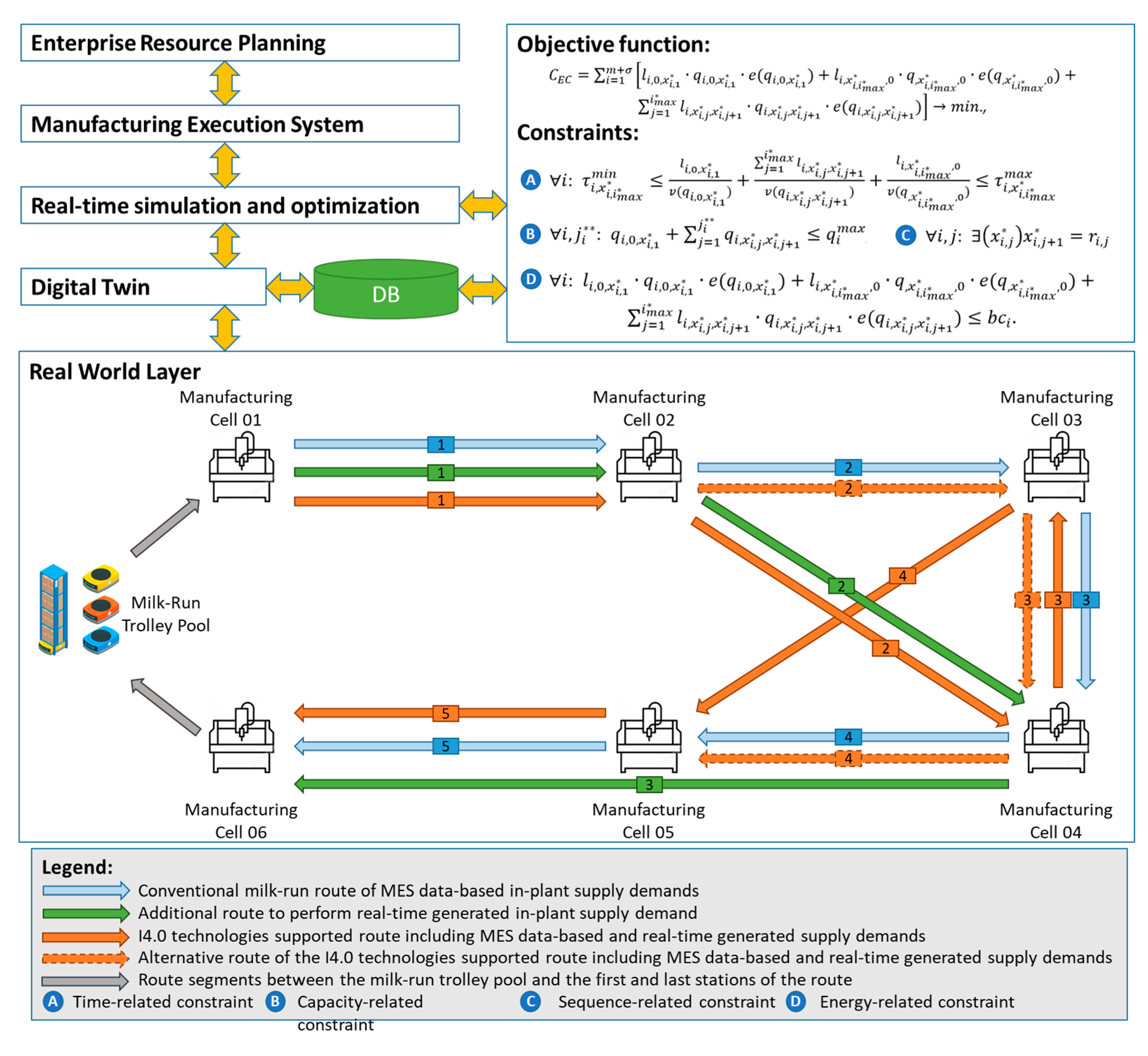
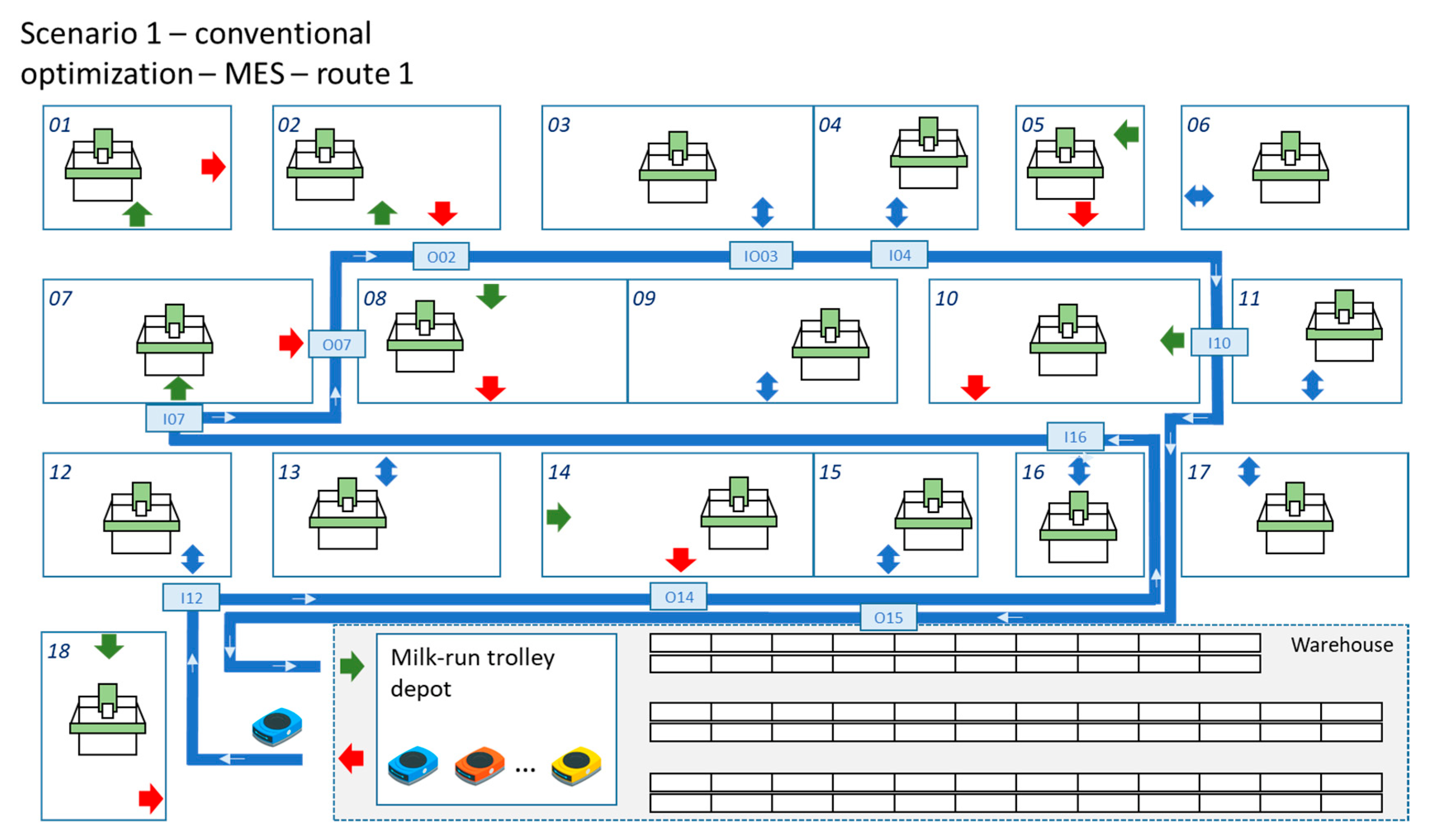


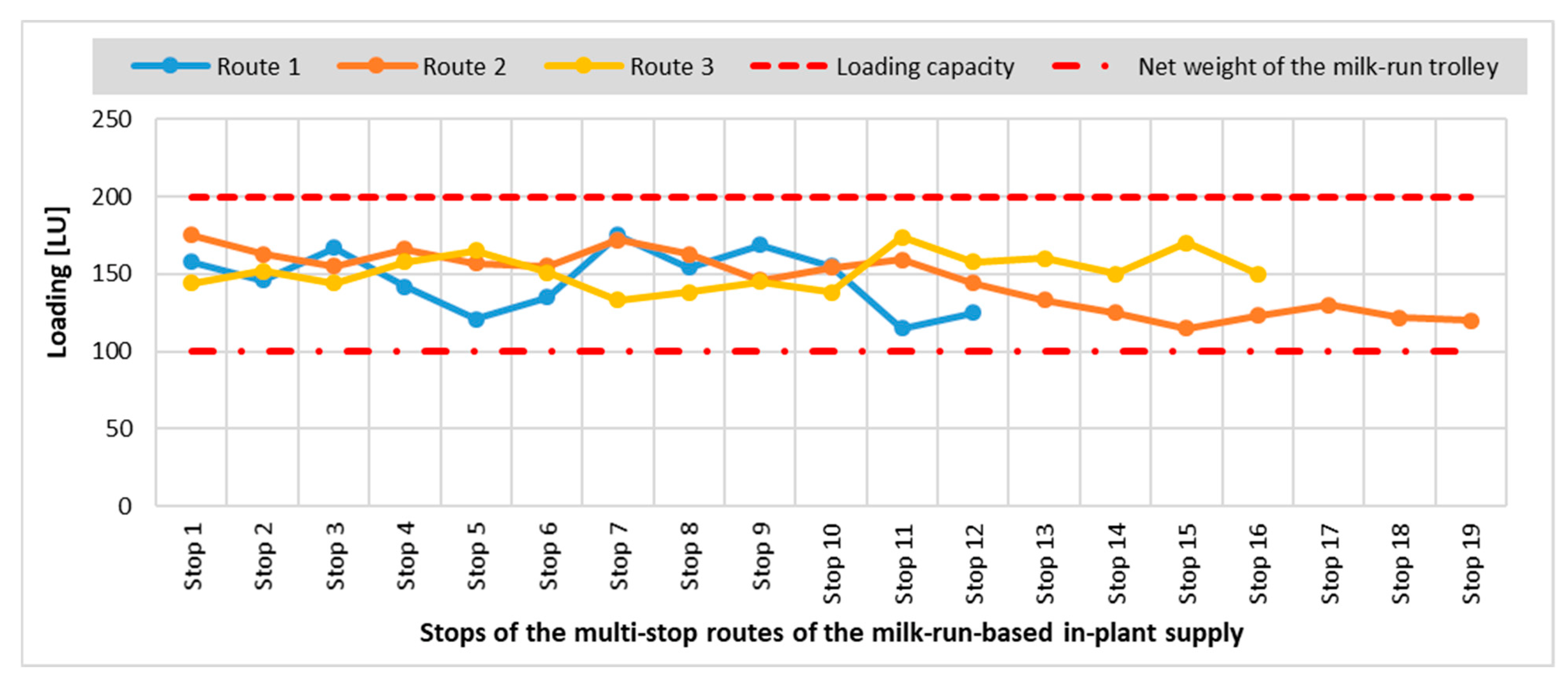
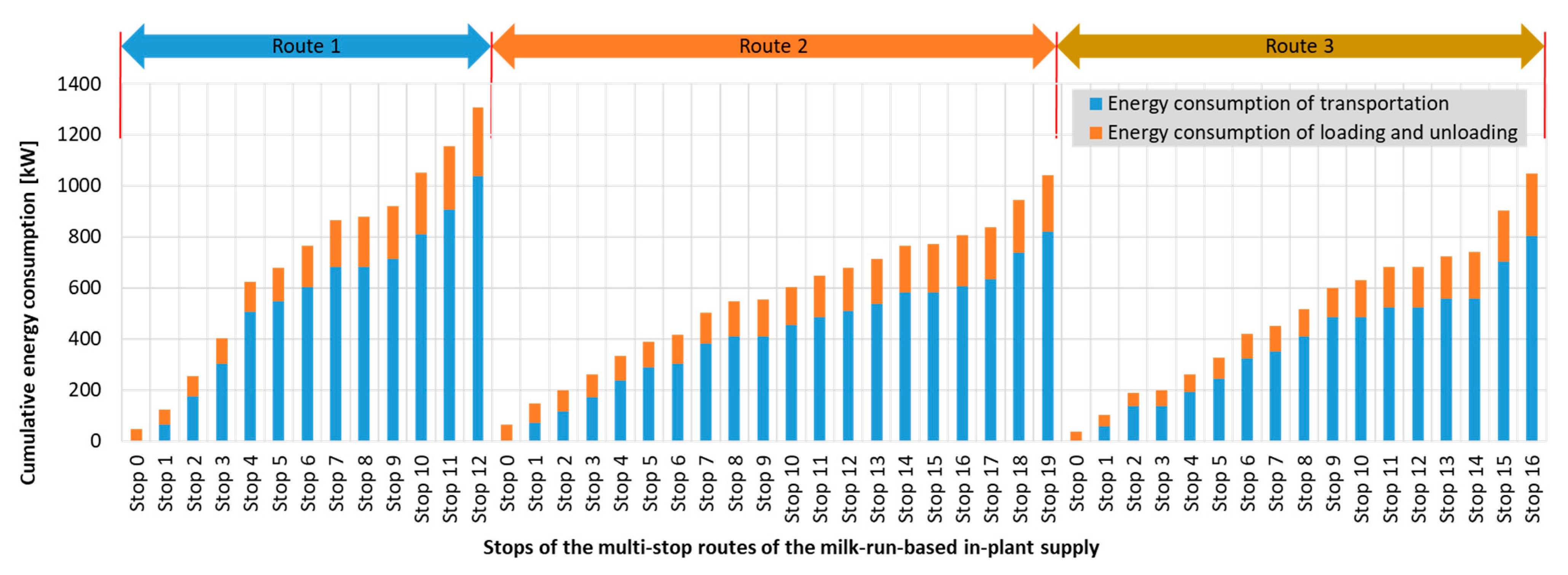
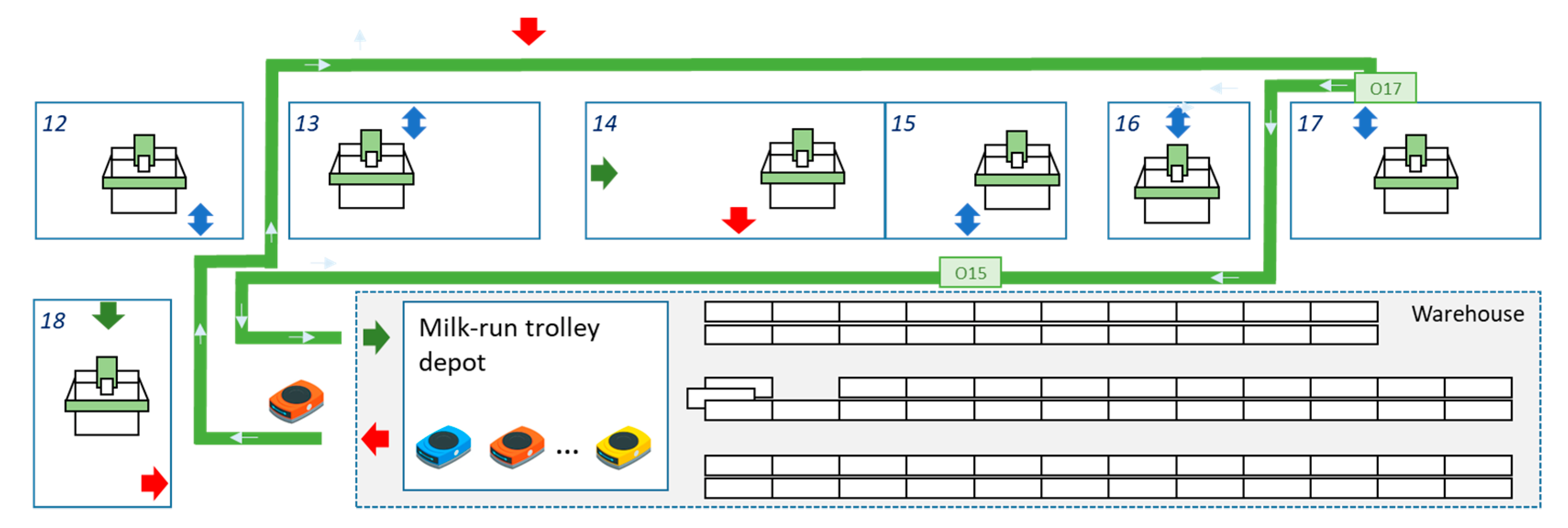

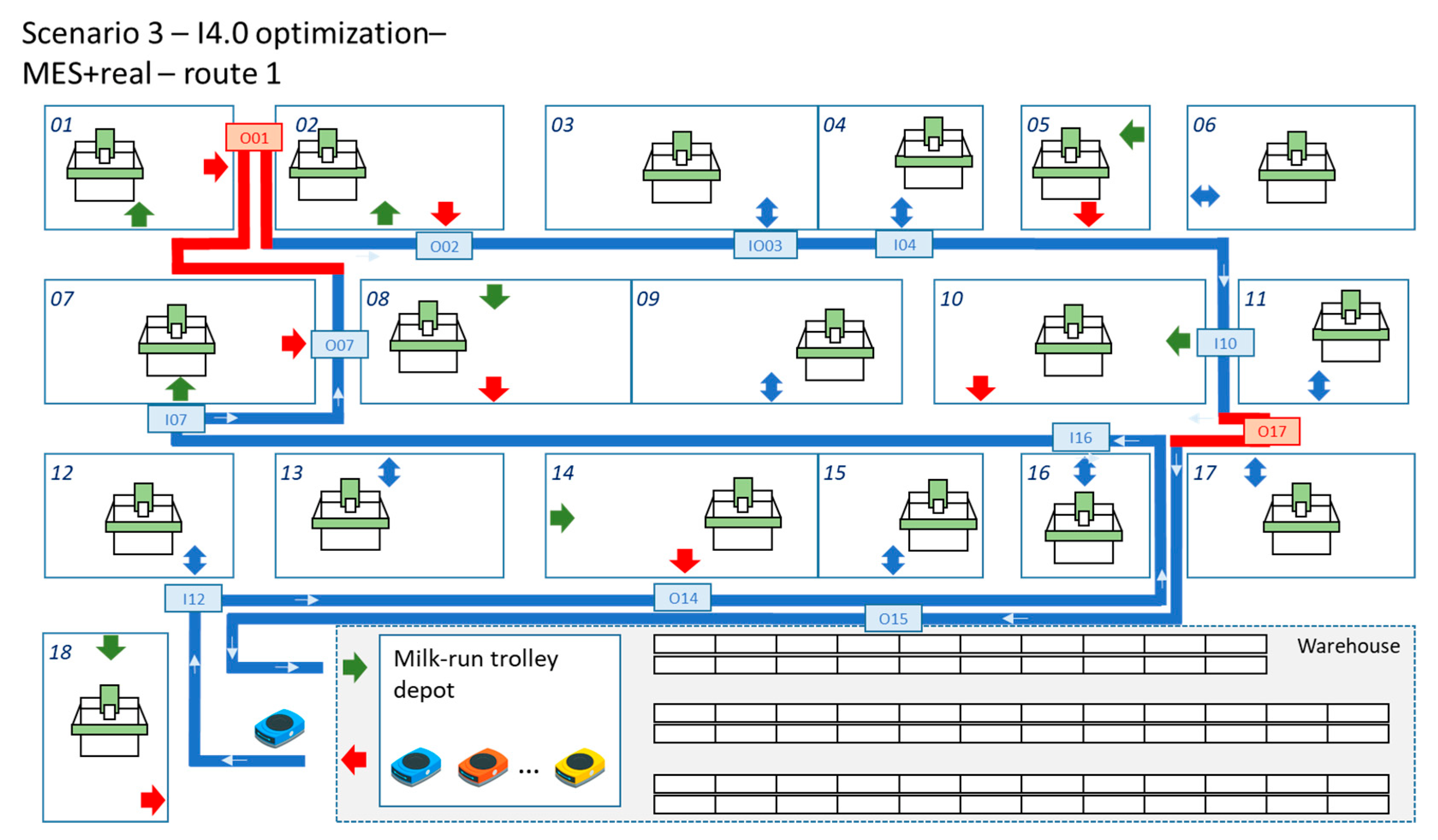
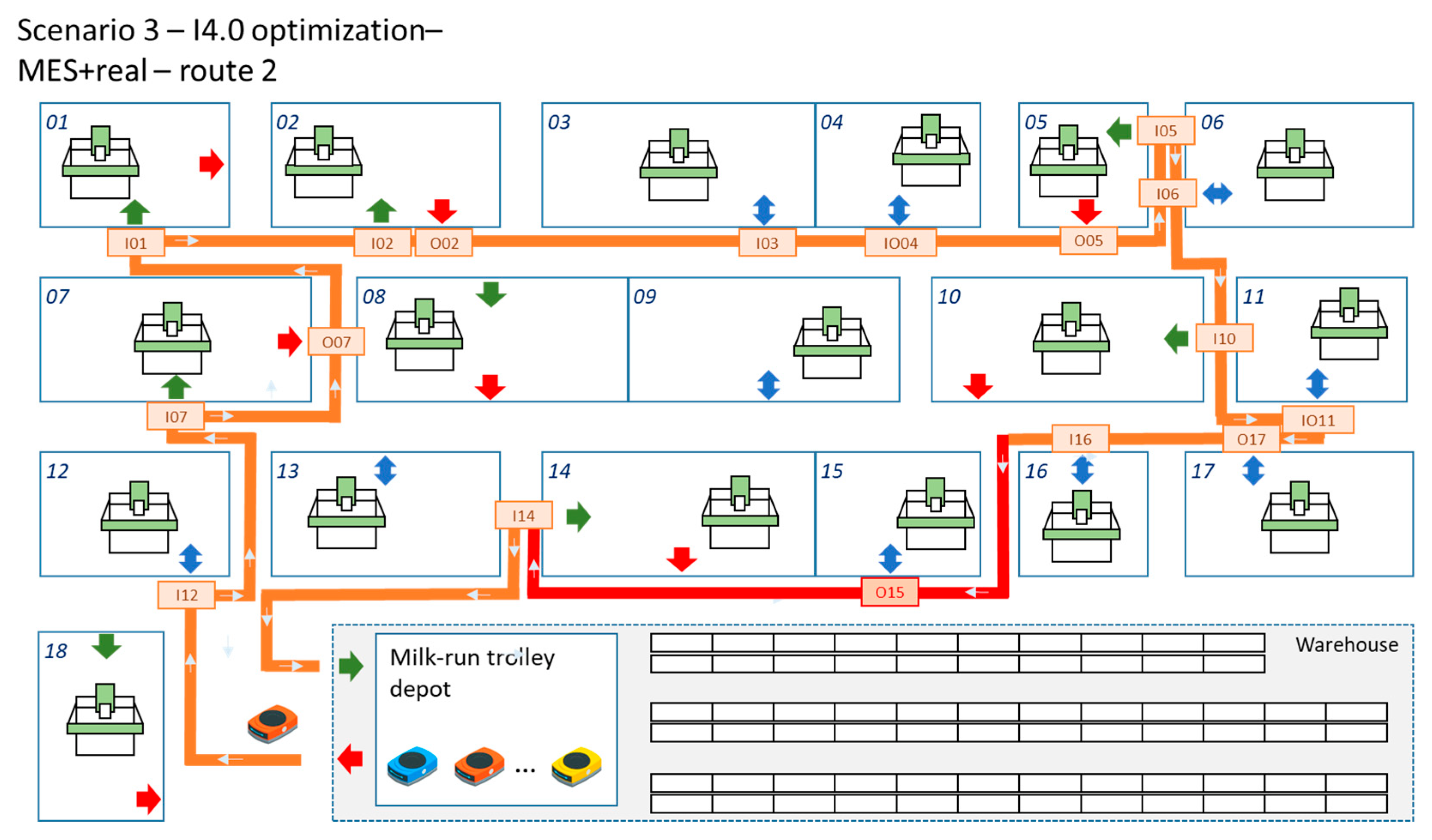
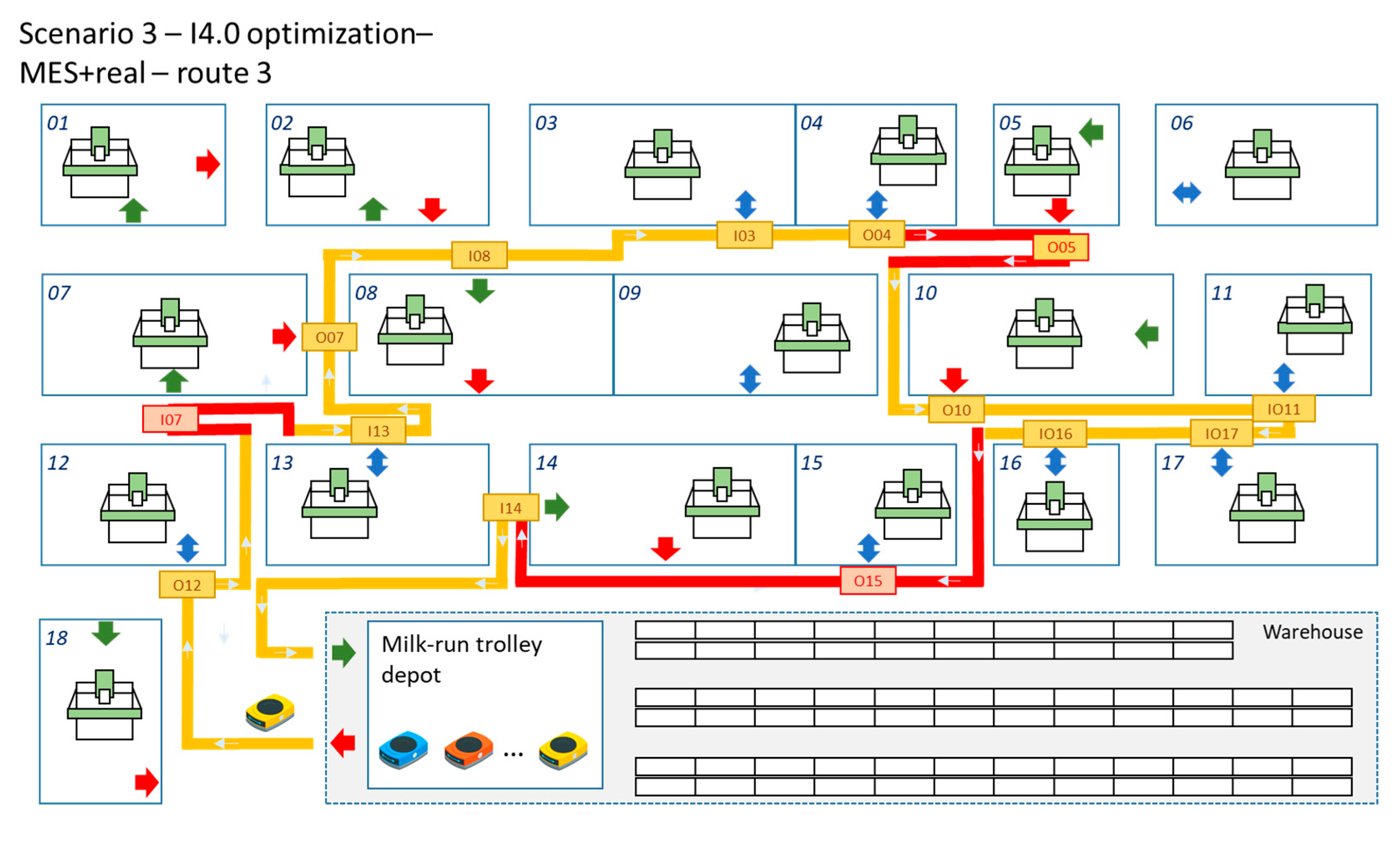


| S_ID * | C_ID 1 | Type 2 | From 3 | To 4 | LOAD 5 | CLO 6 | TFRAME 7 | TSCHED 8 | ECT 9 | ECH 10 | EC 11 |
|---|---|---|---|---|---|---|---|---|---|---|---|
| S_00 | C_00 | - | - | - | 100 | 158 | - | 3:27:36 | 49.5 | 49.5 | |
| S_01 | C_12 | LO | C_00 | - | 12 | 146 | 03:28:00–03:30:00 | 3:29:10 | 65.8 | 10.2 | 125.5 |
| S_02 | C_14 | UNLO | - | C_03 | 21 | 167 | 03:30:00–03:32:00 | 3:31:35 | 111.4 | 17.9 | 254.9 |
| S_03 | C_16 | LO | C_00 | - | 25 | 142 | 03:30:00–03:35:00 | 3:34:00 | 127.4 | 21.4 | 403.7 |
| S_04 | C_07 | LO | C_00 | - | 21 | 121 | 03:35:00–03:40:00 | 3:38:04 | 203.6 | 17.9 | 625.2 |
| S_05 | C_07 | UNLO | - | C_04 | 14 | 135 | 03:35:00–03:40:00 | 3:39:28 | 42.0 | 12.0 | 679.1 |
| S_06 | C_02 | UNLO | - | C_10 | 40 | 175 | 03:40:00–03:43:00 | 3:40:58 | 53.1 | 34.2 | 766.4 |
| S_07 | C_03 | LO | C_14 | - | 21 | 154 | 03:42:00–03:45:00 | 3:42:38 | 80.9 | 17.9 | 865.2 |
| S_08 | C_03 | UNLO | - | C_00 | 15 | 169 | 03:42:00–03:46:00 | 3:43:10 | 0.0 | 12.8 | 878.1 |
| S_09 | C_04 | LO | C_07 | - | 14 | 155 | 03:44:00–03:47:00 | 3:44:10 | 31.3 | 12.0 | 921.3 |
| S_10 | C_10 | LO | C_02 | - | 40 | 115 | 03:45:00–03:48:00 | 3:46:14 | 96.8 | 34.2 | 1052.2 |
| S_11 | C_15 | UNLO | - | C_00 | 10 | 125 | 03:46:00–03:50:00 | 3:48:50 | 95.7 | 8.5 | 1156.5 |
| S_12 | C_00 | - | - | - | 0 | 125 | - | 3:51:56 | 130.1 | 21.4 | 1307.9 |
| S_ID * | S_ID 1 | Type 2 | From 3 | To 4 | LOAD 5 | CLO 6 | TFRAME 7 | TSCHED 8 | ECT 9 | ECH 10 | EC 11 |
|---|---|---|---|---|---|---|---|---|---|---|---|
| S_00 | C_00 | - | - | - | 100 | 175 | - | 3:45:40 | - | 64.1 | 64.1 |
| S_01 | C_12 | LO | C_00 | - | 12 | 163 | 03:47:00–03:50:00 | 3:47:14 | 72.8 | 10.2 | 147.1 |
| S_02 | C_07 | LO | C_00 | - | 8 | 155 | 03:48:00–03:50:00 | 3:48:27 | 45.2 | 6.8 | 199.2 |
| S_03 | C_07 | UNLO | - | C_06 | 11 | 166 | 03:48:00–03:50:00 | 3:49:50 | 53.8 | 9.4 | 262.4 |
| S_04 | C_01 | LO | C_00 | - | 9 | 157 | 03:50:00–03:53:00 | 3:51:20 | 65.3 | 7.7 | 335.3 |
| S_05 | C_02 | LO | C_00 | - | 2 | 155 | 03:52:00–03:53:00 | 3:52:44 | 54.5 | 1.7 | 391.5 |
| S_06 | C_02 | UNLO | - | C_04 | 17 | 172 | 03:52:00–03:57:00 | 3:53:26 | 10.8 | 14.5 | 416.7 |
| S_07 | C_03 | LO | C_00 | - | 9 | 163 | 03:54:00–03:57:00 | 3:55:07 | 79.6 | 7.7 | 504.0 |
| S_08 | C_04 | LO | C_02 | - | 17 | 146 | 03:55:00–03:57:00 | 3:56:06 | 30.2 | 14.5 | 548.7 |
| S_09 | C_04 | UNLO | - | C_00 | 8 | 154 | 03:55:00–03:57:00 | 3:56:38 | 0.0 | 6.8 | 555.5 |
| S_10 | C_05 | UNLO | - | C_00 | 5 | 159 | 03:56:00–03:59:00 | 3:57:51 | 42.7 | 4.3 | 602.5 |
| S_11 | C_05 | LO | C_00 | - | 15 | 144 | 03:57:00–04:04:00 | 3:58:54 | 33.1 | 12.8 | 648.4 |
| S_12 | C_06 | LO | C_07 | - | 11 | 133 | 03:58:00–04:04:00 | 3:59:50 | 23.3 | 9.4 | 681.1 |
| S_13 | C_10 | LO | C_00 | - | 8 | 125 | 03:59:00–04:04:00 | 4:00:53 | 27.7 | 6.8 | 715.6 |
| S_14 | C_11 | LO | C_00 | - | 10 | 115 | 04:00:00–04:04:00 | 4:02:16 | 43.4 | 8.5 | 767.5 |
| S_15 | C_11 | UNLO | - | C_16 | 8 | 123 | 04:02:00–04:05:00 | 4:02:48 | 0.0 | 6.8 | 774.3 |
| S_16 | C_17 | UNLO | - | C_00 | 7 | 130 | 04:03:00–04:06:00 | 4:03:51 | 25.6 | 6.0 | 805.9 |
| S_17 | C_16 | LO | C_11 | - | 8 | 122 | 04:03:00–04:06:00 | 4:04:54 | 27.1 | 6.8 | 839.8 |
| S_18 | C_14 | LO | C_00 | - | 2 | 120 | 04:06:00–04:11:00 | 4:07:33 | 104.4 | 1.7 | 945.9 |
| S_19 | C_00 | - | - | - | 0 | 120 | - | 4:09:44 | 80.5 | 17.1 | 1043.5 |
| S_ID * | S_ID 1 | Type 2 | From 3 | To 4 | LOAD 5 | CLO 6 | TFRAME 7 | TSCHED 8 | ECT 9 | ECH 10 | EC 11 |
|---|---|---|---|---|---|---|---|---|---|---|---|
| S_00 | C_00 | - | - | - | 100 | 144 | 4:13:51 | 37.6 | 37.6 | ||
| S_01 | C_12 | UNLO | - | C_13 | 8 | 152 | 04:15:00–04:17:00 | 4:15:25 | 59.9 | 6.8 | 104.3 |
| S_02 | C_13 | LO | C_12 | - | 8 | 144 | 04:15:00–04:20:00 | 4:17:12 | 77.3 | 6.8 | 188.5 |
| S_03 | C_13 | UNLO | - | C_08 | 14 | 158 | 04:16:00–04:20:00 | 4:17:44 | 0.0 | 12.0 | 200.5 |
| S_04 | C_07 | UNLO | - | C_11 | 7 | 165 | 04:18:00–04:21:00 | 4:19:07 | 54.8 | 6.0 | 261.3 |
| S_05 | C_08 | LO | C_13 | - | 14 | 151 | 04:19:00–04:22:00 | 4:20:27 | 53.4 | 12.0 | 326.6 |
| S_06 | C_03 | LO | C_00 | - | 18 | 133 | 04:21:00–04:24:00 | 4:22:18 | 80.3 | 15.4 | 422.3 |
| S_07 | C_04 | UNLO | - | C_00 | 5 | 138 | 04:22:00–04:25:00 | 4:23:18 | 24.6 | 4.3 | 451.2 |
| S_08 | C_10 | UNLO | - | C_00 | 7 | 145 | 04:24:00–04:30:00 | 4:24:55 | 60.6 | 6.0 | 517.8 |
| S_09 | C_11 | LO | C_07 | - | 7 | 138 | 04:24:00–04:30:00 | 4:26:45 | 77.1 | 6.0 | 600.9 |
| S_10 | C_11 | UNLO | - | C_00 | 36 | 174 | 04:27:00–04:30:00 | 4:27:17 | 0.0 | 30.7 | 631.6 |
| S_11 | C_17 | LO | C_00 | - | 16 | 158 | 04:27:00–04:33:00 | 4:28:20 | 36.2 | 13.7 | 681.5 |
| S_12 | C_17 | UN | - | C_00 | 2 | 160 | 04:28:00–04:33:00 | 4:28:52 | 0.0 | 1.7 | 683.2 |
| S_13 | C_16 | LO | C_00 | - | 10 | 150 | 04:28:00–04:33:00 | 4:29:55 | 33.3 | 8.5 | 725.1 |
| S_14 | C_16 | UNLO | - | C_14 | 20 | 170 | 04:30:00–04:33:00 | 4:30:27 | 0.0 | 17.1 | 742.1 |
| S_15 | C_14 | LO | C_16 | - | 20 | 150 | 04:30:00–04:37:00 | 4:33:06 | 145.5 | 17.1 | 904.7 |
| S_16 | C_00 | - | - | - | 0 | 150 | 4:35:17 | 100.6 | 42.7 | 1048.0 |
| S_ID * | C_ID 1 | Type 2 | From 3 | To 4 | LOAD 5 | CLO 6 | TFRAME 7 | TSCHED 8 | ECT 9 | ECH 10 | EC 11 |
|---|---|---|---|---|---|---|---|---|---|---|---|
| S_00 | C_00 | - | - | - | 100 | 100 | - | 4:01:40 | 0.0 | 0.0 | |
| S_01 | C_17 | UNLO | - | C_15 | 24 | 124 | 04:03:00–04:06:00 | 4:06:29 | 173.4 | 20.5 | 193.9 |
| S_02 | C_15 | LO | C_17 | - | 24 | 100 | 04:03:00–04:08:00 | 4:08:44 | 86.0 | 20.5 | 300.5 |
| S_03 | C_00 | - | - | - | 0 | 100 | - | 4:11:50 | 104.1 | 0.0 | 404.5 |
| S_ID * | C_ID 1 | Type 2 | From 3 | To 4 | LOAD 5 | CLO 6 | TFRAME 7 | TSCHED 8 | ECT 9 | ECH 10 | EC 11 |
|---|---|---|---|---|---|---|---|---|---|---|---|
| S_00 | C_00 | - | - | - | 100 | 134 | - | 4:13:51 | 29.0 | 29.0 | |
| S_01 | C_07 | LO | C_00 | - | 34 | 100 | 04:15:00–04:17:00 | 4:16:06 | 93.0 | 29.0 | 151.0 |
| S_02 | C_05 | UNLO | - | C_15 | 21 | 121 | 04:20:00–04:30:00 | 4:20:44 | 166.5 | 17.9 | 335.5 |
| S_03 | C_15 | LO | C_05 | - | 21 | 100 | 04:22:00–04:35:00 | 4:23:23 | 103.5 | 17.9 | 456.9 |
| S_04 | C_00 | - | - | - | 0 | 100 | - | 4:25:38 | 69.4 | 0.0 | 526.3 |
| S_ID * | C_ID 1 | Type 2 | From 3 | To 4 | LOAD 5 | CLO 6 | TFRAME 7 | TSCHED 8 | ECT 9 | ECH 10 | EC 11 |
|---|---|---|---|---|---|---|---|---|---|---|---|
| S_00 | C_00 | - | - | - | 100 | 158 | - | 3:27:36 | 49.5 | 49.5 | |
| S_01 | C_12 | LO | C_00 | - | 12 | 146 | 03:28:00–03:30:00 | 3:29:10 | 65.8 | 10.2 | 125.5 |
| S_02 | C_14 | UNLO | - | C_03 | 21 | 167 | 03:30:00–03:32:00 | 3:31:35 | 111.4 | 17.9 | 254.9 |
| S_03 | C_16 | LO | C_00 | - | 25 | 142 | 03:30:00–03:35:00 | 3:34:00 | 127.4 | 21.4 | 403.7 |
| S_04 | C_07 | LO | C_00 | - | 21 | 121 | 03:35:00–03:40:00 | 3:38:04 | 203.6 | 17.9 | 625.2 |
| S_05 | C_07 | UNLO | - | C_04 | 14 | 135 | 03:35:00–03:40:00 | 3:39:28 | 42.0 | 12.0 | 679.1 |
| S_06 | C_01 | UNLO | - | C_17 | 12 | 147 | 03:40:00–03:42:00 | 3:40:54 | 50.0 | 10.2 | 739.3 |
| S_07 | C_02 | UNLO | - | C_10 | 40 | 187 | 03:40:00–03:43:00 | 3:42:25 | 57.8 | 34.2 | 831.3 |
| S_08 | C_03 | LO | C_14 | - | 21 | 166 | 03:42:00–03:45:00 | 3:44:05 | 86.5 | 17.9 | 935.7 |
| S_09 | C_03 | UNLO | - | C_00 | 15 | 181 | 03:42:00–03:46:00 | 3:44:37 | 0.0 | 12.8 | 948.5 |
| S_10 | C_04 | LO | C_07 | - | 14 | 167 | 03:44:00–03:47:00 | 3:45:37 | 33.5 | 12.0 | 994.0 |
| S_11 | C_10 | LO | C_02 | - | 40 | 127 | 03:45:00–03:48:00 | 3:47:41 | 104.3 | 34.2 | 1132.4 |
| S_12 | C_17 | LO | C_01 | - | 12 | 139 | 03:46:00–03:50:00 | 3:48:54 | 35.2 | 10.2 | 1177.9 |
| S_13 | C_15 | UNLO | - | C_00 | 10 | 137 | 03:46:00–03:50:00 | 3:49:56 | 88.1 | 8.5 | 1274.5 |
| S_14 | C_00 | - | - | - | 0 | 137 | - | 3:53:02 | 142.6 | 31.6 | 1448.7 |
| S_ID * | S_ID 1 | Type 2 | From 3 | To 4 | LOAD 5 | CLO 6 | TFRAME 7 | TSCHED 8 | ECT 9 | ECH 10 | EC 11 |
|---|---|---|---|---|---|---|---|---|---|---|---|
| S_00 | C_00 | - | - | - | 100 | 175 | - | 3:45:40 | - | 64.1 | 64.1 |
| S_01 | C_12 | LO | C_00 | - | 12 | 163 | 03:47:00–03:50:00 | 3:47:14 | 72.8 | 10.2 | 147.1 |
| S_02 | C_07 | LO | C_00 | - | 8 | 155 | 03:48:00–03:50:00 | 3:48:27 | 45.2 | 6.8 | 199.2 |
| S_03 | C_07 | UNLO | - | C_06 | 11 | 166 | 03:48:00–03:50:00 | 3:49:50 | 53.8 | 9.4 | 262.4 |
| S_04 | C_01 | LO | C_00 | - | 9 | 157 | 03:50:00–03:53:00 | 3:51:20 | 65.3 | 7.7 | 335.3 |
| S_05 | C_02 | LO | C_00 | - | 2 | 155 | 03:52:00–03:53:00 | 3:52:44 | 54.5 | 1.7 | 391.5 |
| S_06 | C_02 | UNLO | - | C_04 | 17 | 172 | 03:52:00–03:57:00 | 3:53:26 | 10.8 | 14.5 | 416.7 |
| S_07 | C_03 | LO | C_00 | - | 9 | 163 | 03:54:00–03:57:00 | 3:55:07 | 79.6 | 7.7 | 504.0 |
| S_08 | C_04 | LO | C_02 | - | 17 | 146 | 03:55:00–03:57:00 | 3:56:06 | 30.2 | 14.5 | 548.7 |
| S_09 | C_04 | UNLO | - | C_00 | 8 | 154 | 03:55:00–03:57:00 | 3:56:38 | 0.0 | 6.8 | 555.5 |
| S_10 | C_05 | UNLO | - | C_00 | 5 | 159 | 03:56:00–03:59:00 | 3:57:51 | 42.7 | 4.3 | 602.5 |
| S_11 | C_05 | LO | C_00 | - | 15 | 144 | 03:57:00–04:04:00 | 3:58:54 | 33.1 | 12.8 | 648.4 |
| S_12 | C_06 | LO | C_07 | - | 11 | 133 | 03:58:00–04:04:00 | 3:59:50 | 23.3 | 9.4 | 681.1 |
| S_13 | C_10 | LO | C_00 | - | 8 | 125 | 03:59:00–04:04:00 | 4:00:53 | 27.7 | 6.8 | 715.6 |
| S_14 | C_11 | LO | C_00 | - | 10 | 115 | 04:00:00–04:04:00 | 4:02:16 | 43.4 | 8.5 | 767.5 |
| S_15 | C_11 | UNLO | - | C_16 | 8 | 123 | 04:02:00–04:05:00 | 4:02:48 | 0.0 | 6.8 | 774.3 |
| S_16 | C_17 | UNLO | - | C_00 | 7 | 130 | 04:03:00–04:06:00 | 4:03:51 | 25.6 | 6.0 | 805.9 |
| S_17 | C_17 | UNLO | - | C_15 | 24 | 154 | 04:03:00–04:06:00 | 4:04:23 | 0.0 | 20.5 | 826.4 |
| S_18 | C_16 | LO | C_11 | - | 8 | 146 | 04:03:00–04:06:00 | 4:05:26 | 32.1 | 6.8 | 865.3 |
| S_19 | C_15 | LO | C_17 | - | 24 | 122 | 04:03:00–04:08:00 | 4:07:10 | 70.9 | 20.5 | 956.7 |
| S_20 | C_14 | LO | C_00 | - | 2 | 120 | 04:06:00–04:11:00 | 4:09:11 | 73.4 | 1.7 | 1031.8 |
| S_21 | C_00 | - | - | - | 0 | 120 | - | 4:11:22 | 80.5 | 17.1 | 1129.3 |
| S_ID * | S_ID 1 | Type 2 | From 3 | To 4 | LOAD 5 | CLO 6 | TFRAME 7 | TSCHED 8 | ECT 9 | ECH 10 | EC 11 |
|---|---|---|---|---|---|---|---|---|---|---|---|
| S_00 | C_00 | - | - | - | 100 | 178 | 4:13:51 | 66.6 | 66.6 | ||
| S_01 | C_12 | UNLO | - | C_13 | 8 | 186 | 04:15:00–04:17:00 | 4:15:25 | 74.1 | 6.8 | 147.5 |
| S_02 | C_07 | LO | C_00 | - | 34 | 152 | 04:15:00–04:17:00 | 4:16:38 | 51.6 | 29.0 | 228.2 |
| S_03 | C_13 | LO | C_12 | - | 8 | 144 | 04:15:00–04:20:00 | 4:18:11 | 63.3 | 6.8 | 298.3 |
| S_04 | C_13 | UNLO | - | C_08 | 14 | 158 | 04:16:00–04:20:00 | 4:18:43 | 0.0 | 12.0 | 310.2 |
| S_05 | C_07 | UNLO | - | C_11 | 7 | 165 | 04:18:00–04:21:00 | 4:20:07 | 54.8 | 6.0 | 371.0 |
| S_06 | C_08 | LO | C_13 | - | 14 | 151 | 04:19:00–04:22:00 | 4:21:27 | 53.4 | 12.0 | 436.4 |
| S_07 | C_03 | LO | C_00 | - | 18 | 133 | 04:21:00–04:24:00 | 4:23:18 | 80.3 | 15.4 | 532.1 |
| S_08 | C_04 | UNLO | - | C_00 | 5 | 138 | 04:22:00–04:25:00 | 4:24:17 | 24.6 | 4.3 | 561.0 |
| S_09 | C_05 | UNLO | 0 | C_15 | 21 | 159 | 04:20:00–04:30:00 | 4:25:30 | 38.3 | 17.9 | 617.2 |
| S_10 | C_10 | UNLO | - | C_00 | 7 | 166 | 04:24:00–04:30:00 | 4:27:14 | 77.2 | 6.0 | 700.4 |
| S_11 | C_11 | LO | C_07 | - | 7 | 159 | 04:24:00–04:30:00 | 4:29:05 | 88.3 | 6.0 | 794.7 |
| S_12 | C_11 | UNLO | - | C_00 | 36 | 195 | 04:27:00–04:30:00 | 4:29:37 | 0.0 | 30.7 | 825.4 |
| S_13 | C_17 | LO | C_00 | - | 16 | 179 | 04:27:00–04:33:00 | 4:30:40 | 40.6 | 13.7 | 879.6 |
| S_14 | C_17 | UN | - | C_00 | 2 | 181 | 04:28:00–04:33:00 | 4:31:12 | 0.0 | 1.7 | 881.4 |
| S_15 | C_16 | LO | C_00 | - | 10 | 171 | 04:28:00–04:33:00 | 4:32:15 | 37.7 | 8.5 | 927.6 |
| S_16 | C_16 | UNLO | - | C_14 | 20 | 191 | 04:30:00–04:33:00 | 4:32:47 | 0.0 | 17.1 | 944.6 |
| S_17 | C_15 | LO | C_05 | - | 21 | 170 | 04:22:00–04:35:00 | 4:34:30 | 92.8 | 17.9 | 1055.3 |
| S_18 | C_14 | LO | C_16 | - | 20 | 150 | 04:30:00–04:37:00 | 4:36:32 | 102.2 | 17.1 | 1174.6 |
| S_19 | C_00 | - | - | - | 0 | 150 | 4:39:41 | 159.6 | 42.7 | 1376.9 |
| R_ID 1 | ALRpD 2 | AECpD 3 | ALRpWU 4 | AECpWU 5 | AICpR 6 | CUT 7 | ADfTW 8 | TTfTW 9 |
|---|---|---|---|---|---|---|---|---|
| Scenario 1 | ||||||||
| Route 1 | 52.81 | 118.9 | 2.49 | 5.61 | 53 | 46.8% | 00:00:51 | 00:09:25 |
| Route 2 | 25.08 | 57.97 | 2.70 | 6.25 | 54 | 46.2% | 00:00:40 | 00:11:57 |
| Route 3 | 27.87 | 69.87 | 2.18 | 5.46 | 48 | 52.0% | 00:00:43 | 00:10:50 |
| Route 4 | 186.85 | 255.45 | 15.57 | 21.29 | 96 | 4.0% | 00:00:50 | 00:01:40 |
| Route 5 | 138.75 | 202.25 | 5.78 | 8.43 | 92 | 8.0% | 00:02:36 | 00:05:13 |
| Route 6 | 104.23 | 175.43 | 4.11 | 6.93 | 86 | 13.8% | 00:03:09 | 00:09:28 |
| Total | 89.27 | 146.65 | 5.47 | 8.99 | 72 | 28.4% | 00:01:28 | 00:48:33 |
| Scenario 2 | ||||||||
| Route 1 | 47.82 | 111.44 | 2.42 | 5.64 | 48 | 51.4% | 00:00:51 | 00:11:06 |
| Route 2 | 23.5 | 56.47 | 2.19 | 5.25 | 53 | 46.5% | 00:00:42 | 00:13:59 |
| Route 3 | 28.27 | 76.49 | 1.90 | 5.14 | 35 | 64.5% | 00:01:02 | 00:18:36 |
| Total | 33.19 | 81.47 | 2.17 | 5.34 | 45 | 54.2% | 00:00:52 | 00:43:42 |
Disclaimer/Publisher’s Note: The statements, opinions and data contained in all publications are solely those of the individual author(s) and contributor(s) and not of MDPI and/or the editor(s). MDPI and/or the editor(s) disclaim responsibility for any injury to people or property resulting from any ideas, methods, instructions or products referred to in the content. |
© 2023 by the authors. Licensee MDPI, Basel, Switzerland. This article is an open access article distributed under the terms and conditions of the Creative Commons Attribution (CC BY) license (https://creativecommons.org/licenses/by/4.0/).
Share and Cite
Akkad, M.Z.; Bányai, T. Energy Consumption Optimization of Milk-Run-Based In-Plant Supply Solutions: An Industry 4.0 Approach. Processes 2023, 11, 799. https://doi.org/10.3390/pr11030799
Akkad MZ, Bányai T. Energy Consumption Optimization of Milk-Run-Based In-Plant Supply Solutions: An Industry 4.0 Approach. Processes. 2023; 11(3):799. https://doi.org/10.3390/pr11030799
Chicago/Turabian StyleAkkad, Mohammad Zaher, and Tamás Bányai. 2023. "Energy Consumption Optimization of Milk-Run-Based In-Plant Supply Solutions: An Industry 4.0 Approach" Processes 11, no. 3: 799. https://doi.org/10.3390/pr11030799







